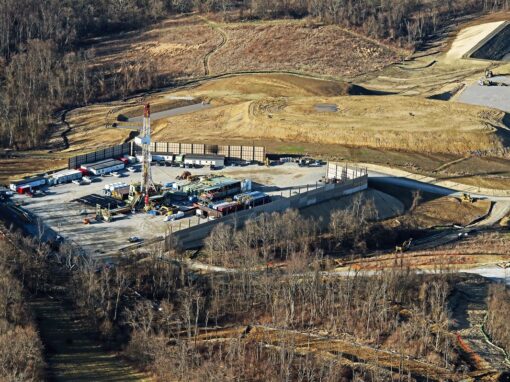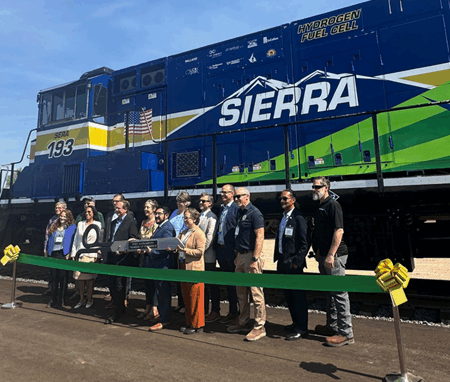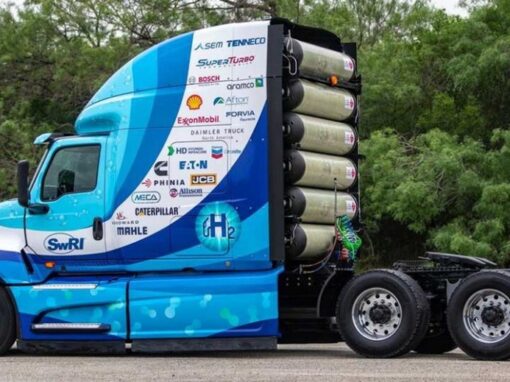The Infrastructure Investment and Jobs Act was signed by President Biden in November of 2021, which provided significant investment into a range of hydrogen and fuel cell initiatives. The centerpiece of these efforts was the creation of a new $8 billion program for the development of Regional Clean Hydrogen Hubs (“Hubs”).This program is intended to demonstrate the large-scale production, processing, delivery, storage, and end-use of clean hydrogen, through the deployment of at least 4 hubs across the United States. The Hubs program is driving significant interest both in the public and private sectors, with groups across the country announcing plans to pursue funds from the program.
On September 22, the Department of Energy released the Funding Opportunity Announcement for the initial $7 billion award of funding. Concept papers for proposals are due by November 7th, with full applications due April 7th, 2023. The initial set of projects chosen will go through several phases of work involving go-no go decision points related to developing detailed plans, ensuring financing and permitting, and installing the selected projects over the coming years.
DOE’s planned phases for the Regional Clean Hydrogen Hub Program.
(Source: DOE)
Application
Pre – DOE Funding
Engineering, Procurement, Construction, Operations
- Conceptual Design
- Technical Readiness
- Project Schedule
- Total Project Cost Estimate
Business Development & Management
- Business Strategy
- Team Description
- Workforce Plan
- Finance Plan
- Market Potential Analysis
Permitting & Safety
- Safety History/Culture Description
- Regulatory Approval Timeline Overview
Community Engagement & Impacts
- Initial Equity Plan addressing community engagement, Justice40, community consent or benefits agreements, job quality, workers rights, etc…
Technical Data & Analysis
- Lifecycle Analysis
- Tehcno-economic Analysis
Phase 1:
Detailed Plan
Up to $10M DOE Funding; Non-Federal Cost Share ≥ 50%; 12-18 Months
Engineering, Procurement, Construction, Operations
- Engineering & Design Documents
- Technical Maturation Plans
- Integrated Project Schedules
Business Development & Management
- Project Management Plan
- Risk Management Plan
- Financial Modeling
- Site Selection
Permitting & Safety
- Initial Hydrogen Safety Plan (HSP) & Site Safety Plan
- Physical, Information, Cyber Security Plans
- Environmental & Regulatory Preparations
Community Engagement & Impacts
- Stakeholder Engagement and Community Consent or Benefits Agreement Drafts
Technical Data & Analysis
- Project Production Model
- Updated Lifecycle and Technoeconomic Analysis
Phase 2: Develop, Permit, Finance
TBD DOE Funding; Non-Federal Cost Share ≥ 50%; 2-3 Years
Engineering, Procurement, Construction, Operations
- Mature Engineering & Design
- Technical Risk Management
- Execution-ready Schedule & Cost Estimate, PM Tools
- Operations Plan
Business Development & Management
- Finalized Project Structure, Management, Financing
- Ongoing Risk Management
- Final Legal, Workforce, Procurement Agreements
- Feedstock & Offtake Plans
Permitting & Safety
- Execution-ready HSP and Security Plans
- Permits & Approvals in Place for Construction
Community Engagement & Impacts
- Finalized Equity Plan, Agreements
- Community Development Targets Identified, Tracking Plans
Technical Data & Analysis
- Final Lifecycle & Technoeconomic Analyses
- V&V and Project Completion Testing Plans
Phase 3: Install, Integrate, Construct
TBD DOE Funding; Non-Federal Cost Share ≥ 50%; 2-4 Years
Engineering, Procurement, Construction, Operations
- Ongoing Execution Reporting
- Interim Go/No-Go Reviews
Business Development & Management
- Ongoing Execution Reporting
- Ongoing Risk Management
Permitting & Safety
- Ongoing Permit, Environmental, Safety Reporting
- Permits & Approvals in Place for Operations
Community Engagement & Impacts
- Ongoing Reporting on Equity Plan Activities
Technical Data & Analysis
- Periodic Analysis Updates
- V&V Data Collection
- Project Completion Testing and Performance Ramp V&V
Phase 4: Ramp-Up & Operate
TBD DOE Funding; Non-Federal Cost Share ≥ 50%; 2-4 Years
Engineering, Procurement, Construction, Operations
- Ongoing Performance Reporting
- Technical Risk Updates, Tracking
- Final TPC Accounting
Business Development & Management
- Updated Financial Analyses
- Revised Growth Plans
- Updated Risk Management
Permitting & Safety
- Ongoing Permit, Safety, and Security Reporting
Community Engagement & Impacts
- Revised Community Engagement Plans for Operations
- Ongoing Reporting and Evaluation
Technical Data & Analysis
- Validated Performance Model
- Finalize Lifecycle and Technoeconomic Analyses
- Dissemination of Analyses, Lessons Learned
Public Partnerships
Public officials have been active in promoting their states’ potential for the Hydrogen Hubs, with announcements taking two main forms – individual state-based public-private partnerships and inter-state governmental partnerships highlighting regional potential.
Three states that announced intentions towards individual state public-private proposals – West Virginia, Kentucky, and California.
In West Virginia, Senator Joe Manchin leads a state working group alongside fellow Senator Shelley Moore Capito, Governor Jim Justice, and Congressman David McKinley. In recent months, the group has solicited information on capacities and interest from private companies within the state, with the aim of putting together a bid that the state will support.
A similar initiative in Kentucky, led by Governor Andy Beshear and the state Energy and Environment Cabinet, has support from local utilities Louisville Gas and Electric and Kentucky Utility Company. The state sees its role as coordinating businesses, organizations, and academic institutions, with hydrogen set as a key component of the statewide energy strategy announced in 2021.
California announced plans in May of 2022 to formally submit a single state-supported proposal that will combine private resources, state funding, and local municipality support. Led by the Governor’s Office of Business and Economic Development, the state plans to match federal funds received through the program with state grants and build on the state’s existing hydrogen infrastructure.
Alongside single state initiatives, public officials across the country are highlighting regional collaborations for hydrogen that cross state borders to encourage significant hydrogen usage.
In the Rocky Mountain region, the governors of New Mexico, Colorado, Utah, and Wyoming agreed to jointly compete for funding through the Hubs program. The partners highlight the existing strong relationships between the states in energy and the ability to build a regional hydrogen network that grows the industry in each state.
A similar partnership was announced earlier this year between the governors of Louisiana, Arkansas, and Oklahoma, which would utilize the Gulf Coast’s existing hydrogen and industrial infrastructure to support further growth.
Governors in the Midwest also established a partnership to advance a hydrogen market and develop supply chains and workforces across the region. The Midwest Hydrogen Coalition includes the governors of Kentucky, Indiana, Illinois, Michigan, Minnesota, Ohio, and Wisconsin, connecting the region with a range of potential sources and end uses.
In the Northeast, the New York State Energy Research and Development Agency (NYSERDA) and Governor Hochul announced they were leading a public-private partnership including Connecticut, Massachusetts, New Jersey, Maine, and Rhode Island, alongside more than 60 public and private organizations, such as the Port Authority of New York and New Jersey, and FCHEA members Advent Technologies, Air Liquide, Bloom Energy, Cummins, FuelCell Energy, HyAxiom, Next Hydrogen, and Plug Power. The resulting consortium will jointly develop a regional proposal for a hydrogen hub and further develop additional hydrogen research and projects to support a proposal.
In the Great Lakes region, a similar public-private initiative was announced to pursue funding based around nuclear-produced hydrogen. In addition to a number of universities in Michigan, Ohio, and Pennsylvania, FCHEA members Plug Power, Nel, and the Ohio Fuel Cell Coalition are looking to utilize the region’s existing nuclear power capacity to reduce emissions across commercial activities including aviation and general transportation.
As demonstrated by the variety of states and regions announcing their interest, support for hydrogen is bipartisan and the technologies are adaptable to many environments and industrial applications.
Private Industry
It’s not just public officials announcing hub proposals and projects, many members of the private sector have also revealed plans to seek investment through the program.
FCHEA member Hy Stor Energy is currently developing a hydrogen hub concept in Mississippi that has secured private investment for its initial commercialization and plans to submit a proposal for the DOE program, as well. The planned facilities will focus on hydrogen storage and distribution throughout the region for a variety of applications, demonstrated by the first announced customers, the Port Bienville Industrial Park and Stennis International Airport.
Further along the Gulf Coast, the Center for Houston’s Future is leading a push for an industry-supported hydrogen hub centered around the city of Houston. This proposal would build on the energy sector and talent that already calls Houston a home, focusing on reducing cost by utilizing existing resources.
In the Pacific Northwest, another non-profit, the Pacific Northwest Hydrogen Association is seeking partners to support a proposal that would develop hydrogen in Washington and Oregon.
Conclusion
Whether organized by public or private entities, there is no doubt that plenty of groups will be applying to the Regional Clean Hydrogen Hub program, in addition to the hydrogen investments already committed beforehand, such as FCHEA member Air Products’ Louisiana hydrogen production facility, fellow FCHEA member Plug Power’s investments in hydrogen production across the country, or the Intermountain Power Project in Delta, Utah, which recently received a loan guarantee through DOE’s Loan Program Office. The Regional Clean Hydrogen Hubs are a fantastic opportunity to expand the growing scale and deploy hydrogen and fuel cell technologies, demonstrating real-world utilization.



